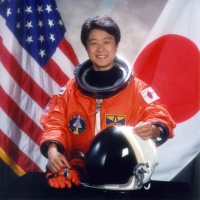Chiaki Mukai
From The Space Library
 Chiaki Mukai | |
| Birth Name | Chiaki Mukai |
|---|---|
| Birth Date | May 6 1952 |
| Occupation | JAXA ASTRONAUT (PAYLOAD SPECIALIST), (M.D., PH.D.) |
Contents |
Personal Data
Born May 6, 1952, in Tatebayashi, Gunma Prefecture, Japan. Married to Makio Mukai, M.D., Ph.D. Recreational interests include snow skiing, Alpine competitive skiing, bass fishing, scuba diving, tennis, golf, photography, American Literature, and traveling.
Education
Graduated from Keio Girls’ High School in Tokyo, in 1971. She received her doctorare in Medicine, Keio University School of Medicine, 1977; a doctorate in physiology, Keio University School of Medicine, 1988; board certified as a cardiovascular surgeon, Japan Surgical Society, 1989.
Experience
Board certified for Medicine in 1977. From 1977 through 1978, Dr. Mukai worked as a Resident in General Surgery, Keio University Hospital, Tokyo. She was on the Medical Staff in General Surgery, Shimizu General Hospital, Shizuoka Prefecture in 1978, and on the Medical Staff in Emergency Surgery, Saiseikai Kanagawa Hospital, Kanawaga Prefecture in 1979. Dr. Mukai began her work as a Resident in Cardiovascular Surgery, Keio University Hospital in 1980 and served on the Medical Staff in Cardiovascular Surgery, Saiseikai Utsunomiya Hospital, Tochigi Prefecture in 1982. She returned to Keio University Hospital in 1983 as the Chief Resident in Cardiovascular Surgery, and was later promoted to Assistant Professor of the Department of Cardiovascular Surgery, Keio University. As a NASDA science astronaut, she was a visiting scientist at the Division of Cardiovascular Physiology, Space Biomedical Research Institute, NASA Johnson Space Center, from 1987 to 1988. Dr. Mukai has remained a Research Instructor of the Department of Surgery, Baylor College of Medicine, Houston, Texas, since 1992. From 1992 to 1998 she was a visiting associate professor of the Department of Surgery, Keio University School of Medicine, Tokyo, and in 1999 was promoted to a visiting professor of the university. Effective October 1, 2003, NASDA merged with ISAS (Institute of Space & Astronautic Science) and NAL (National Aerospace Laboratory of Japan) and was renamed JAXA (Japan Aerospace Exploration Agency).
Spaceflight Experience
NASA EXPERIENCE: In 1985, Dr. Mukai was selected as one of three Japanese Payload Specialist candidates for the First Material Processing Test (Spacelab-J) which flew aboard STS-47. She also served as a back-up payload specialist for the Neurolab (STS-90) mission. Dr. Mukai has logged over 566 hours in space. She flew aboard STS-65 in 1994 and STS-95 in 1998. She is the first Japanese woman to fly in space, and the first Japanese astronaut to fly twice. Dr. Mukai was assigned to the deputy mission scientist for STS-107. In that capacity she coordinated science operations for this science mission. STS-65 Columbia (July 8-23, 1994) was the second International Microgravity Laboratory (IML-2) flight. The mission consisted of 82 investigations of Space Life Science (Human Physiology, Space Biology, Radiation Biology, and Bioprocessing) and Microgravity Science (Material Science, Fluid Science and Research on the Microgravity Environment and Countermeasures). IML-2 was also designated as an extended duration orbit mission focusing on medical experiments related to the cardiovascular system, autonomic nerve system, and bone and muscle metabolism. The mission was accomplished in 236 orbits of the Earth, traveling over 6.1 million miles in 353 hours and 55 minutes. STS-95 Discovery (October 29 to November 7, 1998) was a 9-day mission during which the crew supported a variety of research payloads including deployment of the Spartan solar-observing spacecraft, the Hubble Space Telescope Orbital Systems Test Platform, and investigations on space flight and the aging process. STS-95 is scheduled for launch in October 1998. The mission was accomplished in 134 Earth orbits, traveling 3.6 million miles in 213 hours and 44 minutes.
Special Honours
Outstanding Service Award - The Society of Japanese Women Scientist (1996), Special Congressional Recognition - U.S. Congress (1995), Happy Hands Award - Satte Junior Chamber of Commerce (1995), Aeromedical Association of Korea Honorary Membership (1995), Tatebayashi Children’s Science Exploratorium Honorary President (1995), Prime Minister’s Special Citation for Contributions to Gender Equality (1995), The De La Vaux Medal - The Federation Aeronautique Internationale(1995), The Award for Distinguished Service in Advancement of Space Biology - Japanese Society for Biological Sciences in Space (1995), Prime Minister’s Special Citation (1994), Minister of State for Science and Technology’s Commendation (1994 & 1992), People of Gunma Prefecture’s Certificate of Appreciation (1994), Honorary Citizen of Tatebayashi City (1994), Outstanding Service Award - National Space Development Agency of Japan (1994 & 1992), Award for Distinguished Accomplishments - Tokyo Women’s Foundation ( 1994) and Commendation for Technology - Japan Society of Aeronautical and Space Science ( 1993).
Other Information
PUBLICATIONS: Dr. Mukai is credited with approximately sixty publications since 1979.
Oct-03
